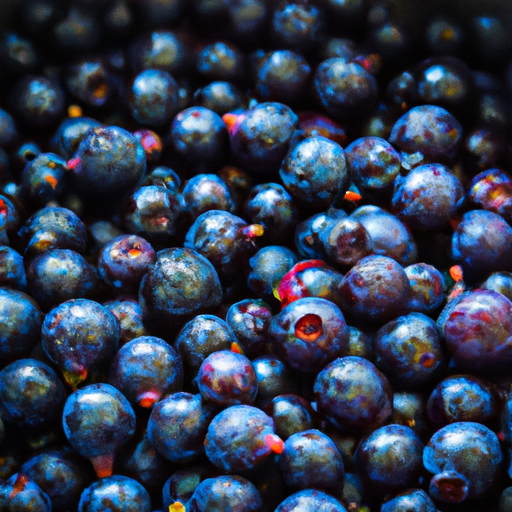The Delightful Wild Blueberries: A Burst of Flavor in Your Kitchen
Are you looking for a flavor-packed ingredient that can add a vibrant touch to your dishes? Look no further than wild blueberries! These tiny powerhouses of flavor are not only delicious but also offer a myriad of culinary possibilities. In this blog post, we’ll explore the taste, cooking uses, nutritional value, and fascinating history of these delectable berries.
The Taste: A Sweet-Tart Symphony
Wild blueberries, with their intense flavor, effortlessly strike a balance between sweetness and tartness. Although similar to cultivated blueberries, their taste is more pronounced, enhancing both savory and sweet dishes. When you bite into a wild blueberry, you’ll experience a burst of tangy juiciness that complements a wide range of ingredients and flavors.
Culinary Versatility: From Breakfast to Dinner
These tasty little berries are remarkably versatile in the kitchen. Their natural sweetness makes them an ideal addition to breakfast options like pancakes, waffles, and smoothie bowls. Create a tantalizing summer salad by tossing them with fresh greens, goat cheese, and walnuts, or whip up a scrumptious wild blueberry sauce to drizzle over a stack of fluffy pancakes.
Wild blueberries are not limited to sweet treats alone. They lend themselves beautifully to savory dishes as well. Try incorporating them into a savory salsa to serve alongside grilled chicken or fold them into a tangy barbecue sauce for a unique twist. Their complex flavor profile can elevate even the simplest of dishes, adding a touch of elegance and depth.
Nutritional Powerhouse: Tiny Berries, Big Benefits
In addition to their incredible taste, wild blueberries are packed with nutritional goodness. These small berries are rich in antioxidants, vitamins, and fiber. Antioxidants help protect the body against cellular damage caused by harmful free radicals, while vitamins like Vitamin C and Vitamin K promote overall health and well-being.
Research suggests that wild blueberries may have numerous health benefits, such as improving brain function, supporting heart health, and aiding digestion. Moreover, their low-calorie content makes them a guilt-free ingredient to include in your favorite recipes.
A Journey Through History: A Berry Full of Surprises
Wild blueberries have a long and fascinating history. Native to North America, these tiny fruits have been cherished by Indigenous peoples for centuries. Native American tribes revered wild blueberries not just as a delicious food source but also for their medicinal properties. It is believed that they used the berries to make teas for various purposes, including aiding digestion and easing coughs.
The cultivation of wild blueberries began in the early 20th century, but they are still predominantly a wild-grown fruit. Maine, Quebec, and the Atlantic provinces of Canada are famous for their vast wild blueberry fields, where harvesting is done by hand to preserve the delicate berries.
Conclusion
Wild blueberries are truly nature’s flavor bomb. Their unique taste, culinary versatility, and impressive health benefits make them a delightful addition to any kitchen. Whether you incorporate them into sweet treats, savory dishes, or experiment with new recipes, these tiny fruits are guaranteed to jazz up your meals. So why not indulge in the captivating world of wild blueberries today?
Note: While cultivated blueberries are available year-round, wild blueberries are typically found frozen. Their frozen form retains their flavor and nutritional value, making them accessible and convenient to use anytime.
What are your favorite ways to enjoy wild blueberries? Share your ideas in the comments below!
Origin and Common Uses:
- Wild blueberries (Vaccinium angustifolium) are native to North America and have been growing in the wild for thousands of years.
- They are mainly found in regions with acidic soil, such as the northeastern United States and eastern Canada.
- Wild blueberries are smaller in size compared to cultivated blueberries, but they are more intensely flavored.
- They are commonly used in various culinary applications, such as baked goods like muffins, pies, and breads. They can also be used in jams, preserves, sauces, salads, smoothies, and as a topping for breakfast cereals, yogurt, and ice cream.
Nutritional Benefits:
- Wild blueberries are a good source of dietary fiber, vitamins, and minerals.
- They are low in calories and fat, making them a healthy choice for those looking to maintain or lose weight.
- They are rich in antioxidants, particularly anthocyanins, which are beneficial compounds that give them their dark blue color. Antioxidants help protect the body against damage from harmful free radicals.
- Wild blueberries are a good source of vitamin C, which is important for the immune system and helps promote healthy skin.
- They also contain vitamin K, which plays a role in blood clotting, as well as small amounts of other vitamins and minerals like manganese and potassium.
Unique Properties and Historical Significance:
- Wild blueberries have a unique “bush-to-burrow” lifecycle, where they rely on birds and animals to spread their seeds. Birds eat the berries and then disperse the seeds through their droppings.
- Native Americans were the first to discover and consume wild blueberries. They used them both as a food source and for medicinal purposes.
- Blueberries, including the wild variety, have been used traditionally in various Native American remedies to treat ailments such as diarrhea, coughs, and inflammation.
- Wild blueberries have gained popularity for their potential health benefits and are often hailed as a “superfood” due to their high antioxidant content.
- Every year, there is a Wild Blueberry Festival held in Machias, Maine, to celebrate the wild blueberry harvest and the history and culture surrounding this fruit.
Note: It’s important to verify the specific nutritional benefits or potential medicinal uses of wild blueberries with credible sources, and to consult with a healthcare professional before using them for therapeutic purposes.




Use the share button below if you liked it.
It makes me smile, when I see it.